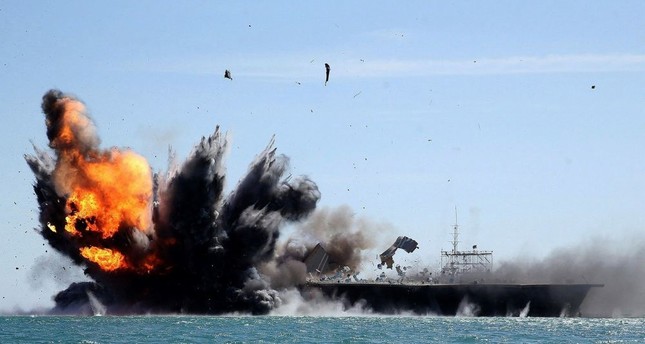Iran holds first major military exercise in Gulf as US concerns rise

Iran’s Revolutionary Guard troops attack a naval vessel during a military drill in the Strait of Hormuz.
Amid rising tension with the United States, Tehran has begun two-day military exercises in the strategic Strait of Hormuz, which has been the scene of confrontations between the rival countries
Iran’s navy began an annual drill Sunday near the strategic Strait of Hormuz, its first major exercise since the inauguration of U.S. President Donald Trump, state television reported.
The TV report quoted navy chief Adm. Habibollah Sayyari as saying the two-day maneuver will cover an area of 2 million square kilometers (772,000 square miles) in the Sea of Oman and the Indian Ocean near the strait. It showed Iranian warships and helicopters taking part in the exercise.
Nearly a third of all oil traded by sea passes through the strait and it has been the scene of previous confrontations between the U.S. and Iran. But the drill does not involve Iran’s elite Revolutionary Guard, a paramilitary force the U.S. Navy often criticizes for harassing its vessels.
The U.S. Navy’s 5th Fleet, based in Bahrain, declined to comment on the exercise or discuss if it had any plans to monitor the drill. Iran’s navy routinely holds war games it says are aimed at improving its readiness against threats. It also sends its warships to international waters off the Gulf of Aden to fight piracy.
The tension has escalated between the two countries after Iran test-fired a new ballistic missile earlier this month, prompting Washington to impose some new sanctions on Tehran.
The Trump administration ordered sanctions against more than two dozen people and companies from the Persian Gulf to China in retaliation for Iran’s recent ballistic missile test, increasing pressure on Tehran without directly undercutting a landmark nuclear deal with the country.
It is Trump’s first package of penalties against Iran, reflecting his insistence on a tougher stance toward Tehran. After tightening sanctions against Iran last week in response to a ballistic missile test, White House officials said the measures were an “initial” step. U.S. Gulf allies have long favored a tougher U.S. stance against Iran, whom they blame for regional interference. Throughout his election campaign, Trump accused the Obama administration of being weak on Iran, and he vowed to crack down if elected.
Iran has acknowledged that it conducted a missile test. But it insists the test didn’t violate the 2015 nuclear accord it reached with the United States and five other world powers, or a subsequent U.N. Security Council resolution extending an eight-year ban on ballistic missiles “designed to be capable of delivering nuclear weapons.” Washington, under Obama and Trump, and its Western allies agree the matter is separate from the nuclear pact but maintain that the missile tests violate the U.N. ban.
Iran’s foreign ministry decried the new U.S. sanctions as “illegitimate.” It vowed counter-sanctions on American companies and firms.
International sanctions on Tehran were lifted in January of last year under a nuclear deal brokered in 2015 by Britain, France, Germany, China, Russia and the United States. Under the nuclear deal, Iran agreed to curb its nuclear program in exchange for most of the sanctions being lifted. According to a 2015 U.N. resolution endorsing the deal, Iran required to refrain from working on ballistic missiles designed to deliver nuclear weapons for up to eight years. Iran has test-fired several ballistic missiles since the nuclear deal in 2015, but the latest test was the first since Trump became president.
Source:Sabah/Turky